Real-Time Ocean Current Compensation for AUV Trajectory Tracking Control Using a Meta-Learning and Self-Adaptation Hybrid Approach
Abstract
1. Introduction
- We employ deep learning theory to improve the adaptive control method instead of completely relying on DNN output. To the best of our knowledge, this is the first combination of meta-learning and adaption in AUV control.
- We evaluate the effectiveness of the proposed method by implementing it in the simulation of a fully actuated six-DOF AUV.
- We provide theoretical guarantees for the feasibility, stability, generalization, and low time complexity of the MAC, which ensures the practical significance of our approach.
2. Modeling and Problem Formulation
2.1. Assumptions
- The AUV is fairly symmetrical about its three planes.
- The center of buoyancy of the AUV is located on the geometric symmetry plane.
- The AUV is considered a rigid body; thus, there are no bending or geometrical deformations.
- The entire AUV body is completely submerged in water.
2.2. Modeling
2.3. DNN Input and Output
2.4. Meta-Learning Goal
2.5. Adaptive Control Goal
3. Meta-Learning-Based Adaptive Control
3.1. Assumptions
- The direction of currents comes from the positive y-axis in the c-frame, but a small range of disturbance is added to the three axes in the c-frame.
- Disturbance is consistent with additive white Gaussian noise (AWGN) with a variance of 0.01.
3.2. Data Collection
3.3. Preparation for Meta-Learning
3.4. Meta-Learning
| Algorithm 1 Meta-Learning Algorithm |
|
3.5. Adaptive Control
4. Simulation Results and Discussion
4.1. DNN Training
4.2. Simulate the Effects of Ocean Currents on AUV
4.3. Control Performance
5. Conclusions
Author Contributions
Funding
Institutional Review Board Statement
Informed Consent Statement
Data Availability Statement
Conflicts of Interest
References
- Zhou, J.; Si, Y.; Chen, Y. A Review of Subsea AUV Technology. J. Mar. Sci. Eng. 2023, 11, 1119. [Google Scholar] [CrossRef]
- Wang, G.; Wei, F.; Jiang, Y.; Zhao, M.; Wang, K.; Qi, H. A Multi-AUV Maritime Target Search Method for Moving and Invisible Objects Based on Multi-Agent Deep Reinforcement Learning. Sensors 2022, 22, 8562. [Google Scholar] [CrossRef]
- Alkanhel, R.; Chaaf, A.; Samee, N.A.; Alohali, M.A.; Muthanna, M.S.A.; Poluektov, D.; Muthanna, A. DEDG: Cluster-Based Delay and Energy-Aware Data Gathering in 3D-UWSN with Optimal Movement of Multi-AUV. Drones 2022, 6, 283. [Google Scholar] [CrossRef]
- Li, D.; Du, L. Auv trajectory tracking models and control strategies: A review. J. Mar. Sci. Eng. 2021, 9, 1020. [Google Scholar] [CrossRef]
- Cheng, C.; Sha, Q.; He, B.; Li, G. Path planning and obstacle avoidance for AUV: A review. Ocean. Eng. 2021, 235, 109355. [Google Scholar] [CrossRef]
- Guerrero, J.; Torres, J.; Creuze, V.; Chemori, A. Trajectory tracking for autonomous underwater vehicle: An adaptive approach. Ocean. Eng. 2019, 172, 511–522. [Google Scholar] [CrossRef]
- Vu, M.T.; Le, T.H.; Thanh, H.L.N.N.; Huynh, T.T.; Van, M.; Hoang, Q.D.; Do, T.D. Robust position control of an over-actuated underwater vehicle under model uncertainties and ocean current effects using dynamic sliding mode surface and optimal allocation control. Sensors 2021, 21, 747. [Google Scholar] [CrossRef]
- Heshmati-Alamdari, S.; Nikou, A.; Dimarogonas, D.V. Robust trajectory tracking control for underactuated autonomous underwater vehicles in uncertain environments. IEEE Trans. Autom. Sci. Eng. 2020, 18, 1288–1301. [Google Scholar] [CrossRef]
- Wang, W.; Wen, T.; He, X.; Xu, G. Path following with prescribed performance for under-actuated autonomous underwater vehicles subjects to unknown actuator dead-zone. IEEE Trans. Intell. Transp. Syst. 2023, 24, 6257–6267. [Google Scholar] [CrossRef]
- Vu, M.T.; Le Thanh, H.N.N.; Huynh, T.T.; Thang, Q.; Duc, T.; Hoang, Q.D.; Le, T.H. Station-keeping control of a hovering over-actuated autonomous underwater vehicle under ocean current effects and model uncertainties in horizontal plane. IEEE Access 2021, 9, 6855–6867. [Google Scholar] [CrossRef]
- Lamraoui, H.C.; Qidan, Z. Path following control of fully-actuated autonomous underwater vehicle in presence of fast-varying disturbances. Appl. Ocean. Res. 2019, 86, 40–46. [Google Scholar] [CrossRef]
- Bingul, Z.; Karahan, O. Comparison of PID and FOPID controllers tuned by PSO and ABC algorithms for unstable and integrating systems with time delay. Optim. Control. Appl. Methods 2018, 39, 1431–1450. [Google Scholar] [CrossRef]
- Bingul, Z.; Gul, K. Intelligent-PID with PD Feedforward Trajectory Tracking Control of an Autonomous Underwater Vehicle. Machines 2023, 11, 300. [Google Scholar] [CrossRef]
- Zhang, Z.; Lin, M.; Li, D. A double-loop control framework for AUV trajectory tracking under model parameters uncertainties and time-varying currents. Ocean. Eng. 2022, 265, 112566. [Google Scholar] [CrossRef]
- Yu, C.; Xiang, X.; Wilson, P.A.; Zhang, Q. Guidance-error-based robust fuzzy adaptive control for bottom following of a flight-style AUV with saturated actuator dynamics. IEEE Trans. Cybern. 2019, 50, 1887–1899. [Google Scholar] [CrossRef]
- Rodriguez, J.; Castañeda, H.; Gordillo, J. Design of an adaptive sliding mode control for a micro-AUV subject to water currents and parametric uncertainties. J. Mar. Sci. Eng. 2019, 7, 445. [Google Scholar] [CrossRef]
- Krstic, M.; Kokotovic, P.V.; Kanellakopoulos, I. Nonlinear and Adaptive Control Design; John Wiley & Sons, Inc.: Hoboken, NJ, USA, 1995. [Google Scholar]
- Shi, X.; Spieler, P.; Tang, E.; Lupu, E.S.; Tokumaru, P.; Chung, S.J. Adaptive nonlinear control of fixed-wing vtol with airflow vector sensing. In Proceedings of the 2020 IEEE International Conference on Robotics and Automation (ICRA), Virtual Event, 31 May–31 August 2020; pp. 5321–5327. [Google Scholar]
- Rahimi, A.; Recht, B. Random features for large-scale kernel machines. In Proceedings of the Twenty-First Annual Conference on Neural Information Processing Systems, Vancouver, BC, Canada, 3–6 December 2007. [Google Scholar]
- Taherkhani, A.; Belatreche, A.; Li, Y.; Cosma, G.; Maguire, L.P.; McGinnity, T.M. A review of learning in biologically plausible spiking neural networks. Neural Netw. 2020, 122, 253–272. [Google Scholar] [CrossRef]
- Cui, R.; Yang, C.; Li, Y.; Sharma, S. Adaptive neural network control of AUVs with control input nonlinearities using reinforcement learning. IEEE Trans. Syst. Man Cybern. Syst. 2017, 47, 1019–1029. [Google Scholar] [CrossRef]
- Yan, Z.; Wang, M.; Xu, J. Robust adaptive sliding mode control of underactuated autonomous underwater vehicles with uncertain dynamics. Ocean. Eng. 2019, 173, 802–809. [Google Scholar] [CrossRef]
- Shi, G.; Shi, X.; O’Connell, M.; Yu, R.; Azizzadenesheli, K.; Anandkumar, A.; Yue, Y.; Chung, S.J. Neural lander: Stable drone landing control using learned dynamics. In Proceedings of the 2019 International Conference on Robotics and Automation (ICRA), Montreal, QC, Canada, 20–24 May 2019; pp. 9784–9790. [Google Scholar]
- O’Connell, M.; Shi, G.; Shi, X.; Chung, S.J. Meta-learning-based robust adaptive flight control under uncertain wind conditions. arXiv 2021, arXiv:2103.01932. [Google Scholar]
- Duan, K.; Fong, S.; Chen, C.P. Reinforcement learning based model-free optimized trajectory tracking strategy design for an AUV. Neurocomputing 2022, 469, 289–297. [Google Scholar] [CrossRef]
- Fang, Y.; Huang, Z.; Pu, J.; Zhang, J. AUV position tracking and trajectory control based on fast-deployed deep reinforcement learning method. Ocean. Eng. 2022, 245, 110452. [Google Scholar] [CrossRef]
- Carlucho, I.; De Paula, M.; Wang, S.; Petillot, Y.; Acosta, G.G. Adaptive low-level control of autonomous underwater vehicles using deep reinforcement learning. Robot. Auton. Syst. 2018, 107, 71–86. [Google Scholar] [CrossRef]
- Jiang, P.; Song, S.; Huang, G. Attention-based meta-reinforcement learning for tracking control of AUV with time-varying dynamics. IEEE Trans. Neural Netw. Learn. Syst. 2021, 33, 6388–6401. [Google Scholar] [CrossRef]
- Creswell, A.; White, T.; Dumoulin, V.; Arulkumaran, K.; Sengupta, B.; Bharath, A.A. Generative adversarial networks: An overview. IEEE Signal Process. Mag. 2018, 35, 53–65. [Google Scholar] [CrossRef]
- Huang, L.; Qin, J.; Zhou, Y.; Zhu, F.; Liu, L.; Shao, L. Normalization techniques in training dnns: Methodology, analysis and application. IEEE Trans. Pattern Anal. Mach. Intell. 2023, 45, 10173–10196. [Google Scholar] [CrossRef] [PubMed]
- Osorio, C. Modeling-and-Simulation-of-an-AUV-in-Simulink. 2021. Available online: https://github.com/mathworks-robotics/modeling-and-simulation-of-an-AUV-in-Simulink (accessed on 15 May 2021).
- Tan, K.; Anvar, A.; Lu, T. Autonomous underwater vehicle (AUV) dynamics modeling and performance evaluation. World Acad. Sci. Eng. Technol. 2012, 6, 2012-10. [Google Scholar]
- Vu, M.T.; Van, M.; Bui, D.H.P.; Do, Q.T.; Huynh, T.T.; Lee, S.D.; Choi, H.S. Study on dynamic behavior of unmanned surface vehicle-linked unmanned underwater vehicle system for underwater exploration. Sensors 2020, 20, 1329. [Google Scholar] [CrossRef]
- Mansoorzadeh, S.; Javanmard, E. An investigation of free surface effects on drag and lift coefficients of an autonomous underwater vehicle (AUV) using computational and experimental fluid dynamics methods. J. Fluids Struct. 2014, 51, 161–171. [Google Scholar] [CrossRef]
- Tian, W.; Song, B.; Ding, H. Numerical research on the influence of surface waves on the hydrodynamic performance of an AUV. Ocean. Eng. 2019, 183, 40–56. [Google Scholar] [CrossRef]
- Mitra, A.; Panda, J.; Warrior, H. The effects of free stream turbulence on the hydrodynamic characteristics of an AUV hull form. Ocean. Eng. 2019, 174, 148–158. [Google Scholar] [CrossRef]
- De Castro, Y.; Gamboa, F.; Henrion, D.; Hess, R.; Lasserre, J.B. Approximate optimal designs for multivariate polynomial regression. Ann. Stat. 2019, 47, 127–155. [Google Scholar] [CrossRef]
- Gühring, I.; Kutyniok, G.; Petersen, P. Error bounds for approximations with deep ReLU neural networks in W s, p norms. Anal. Appl. 2020, 18, 803–859. [Google Scholar] [CrossRef]
- Li, H.; Li, J.; Guan, X.; Liang, B.; Lai, Y.; Luo, X. Research on overfitting of deep learning. In Proceedings of the 2019 15th International Conference on Computational Intelligence and Security (CIS), Macao, China, 13–16 December 2019; pp. 78–81. [Google Scholar]
- Borase, R.P.; Maghade, D.; Sondkar, S.; Pawar, S. A review of PID control, tuning methods and applications. Int. J. Dyn. Control 2021, 9, 818–827. [Google Scholar] [CrossRef]
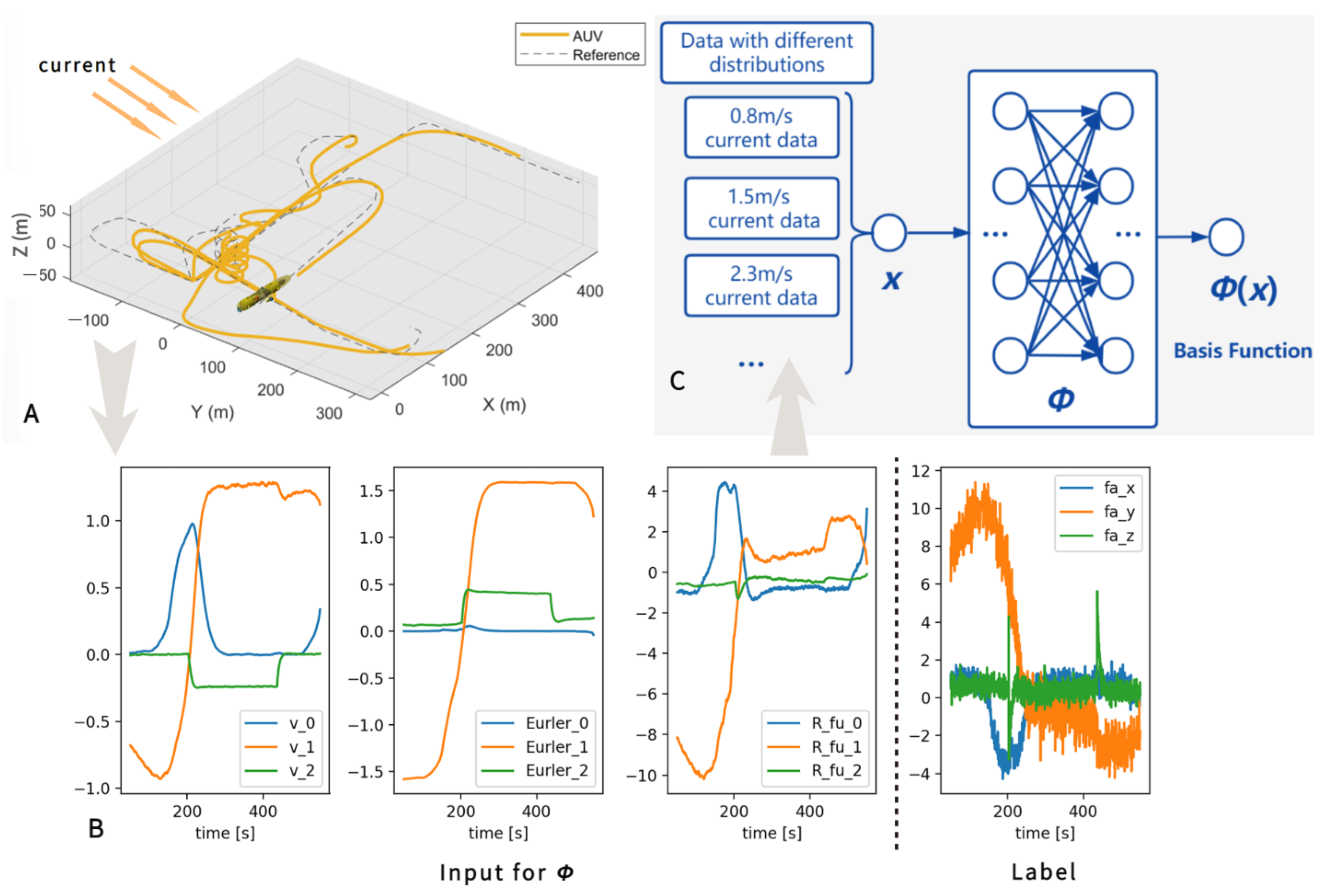




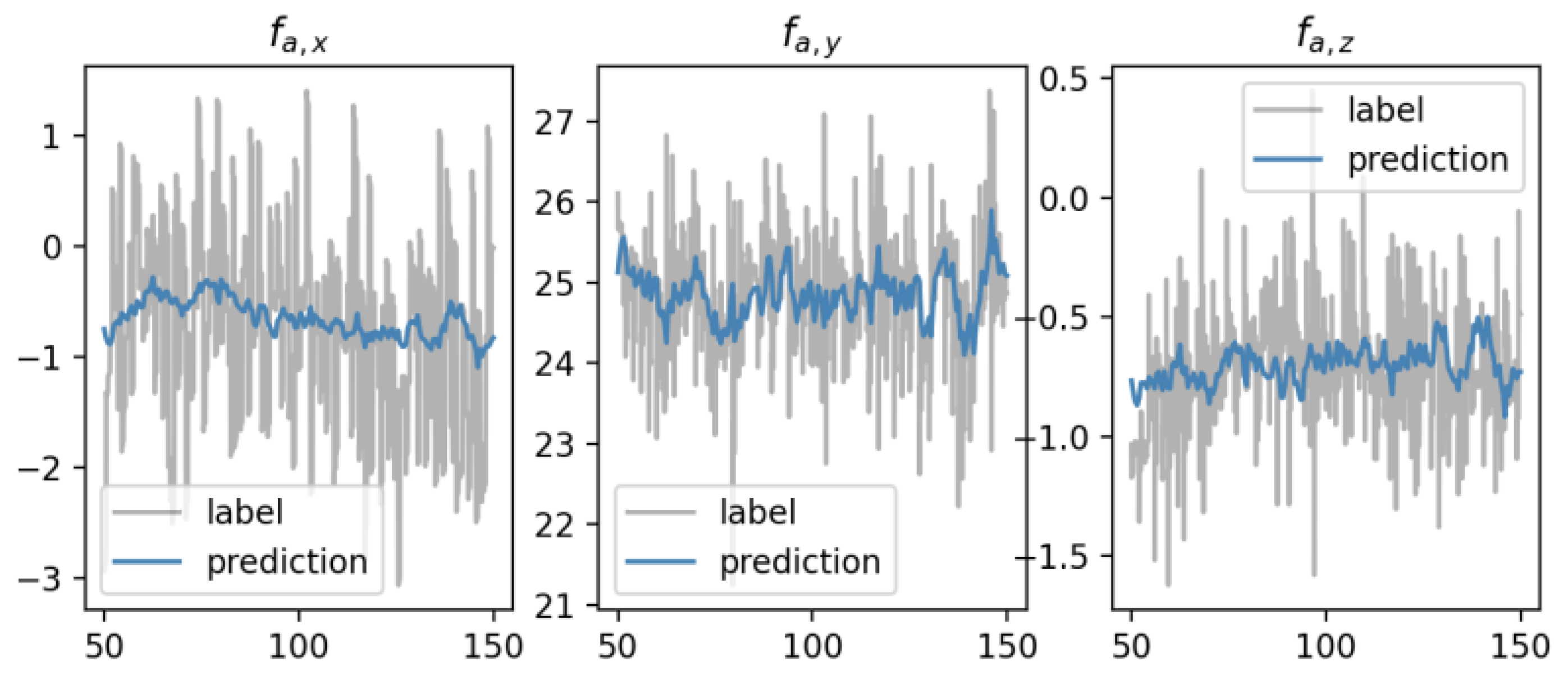
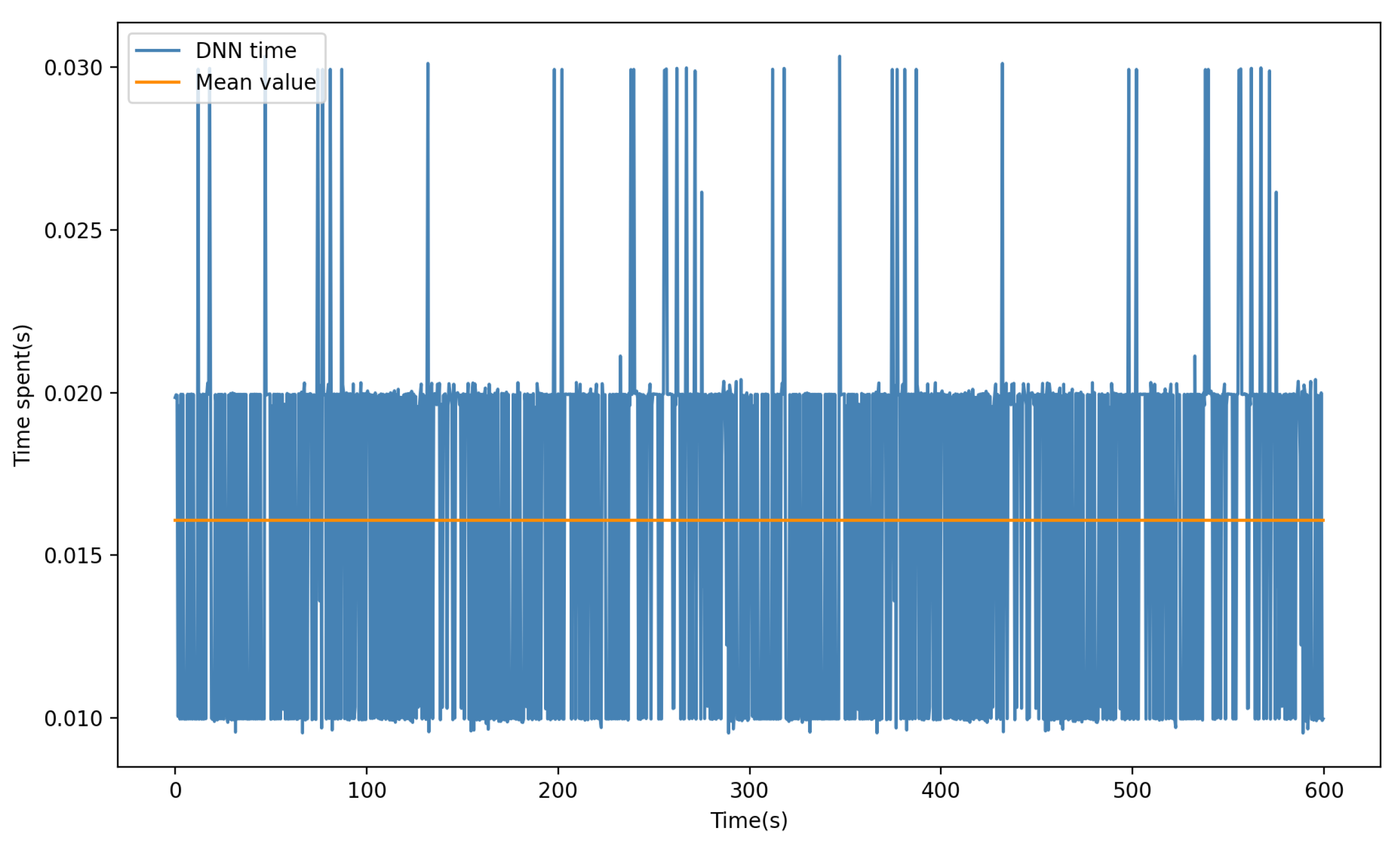
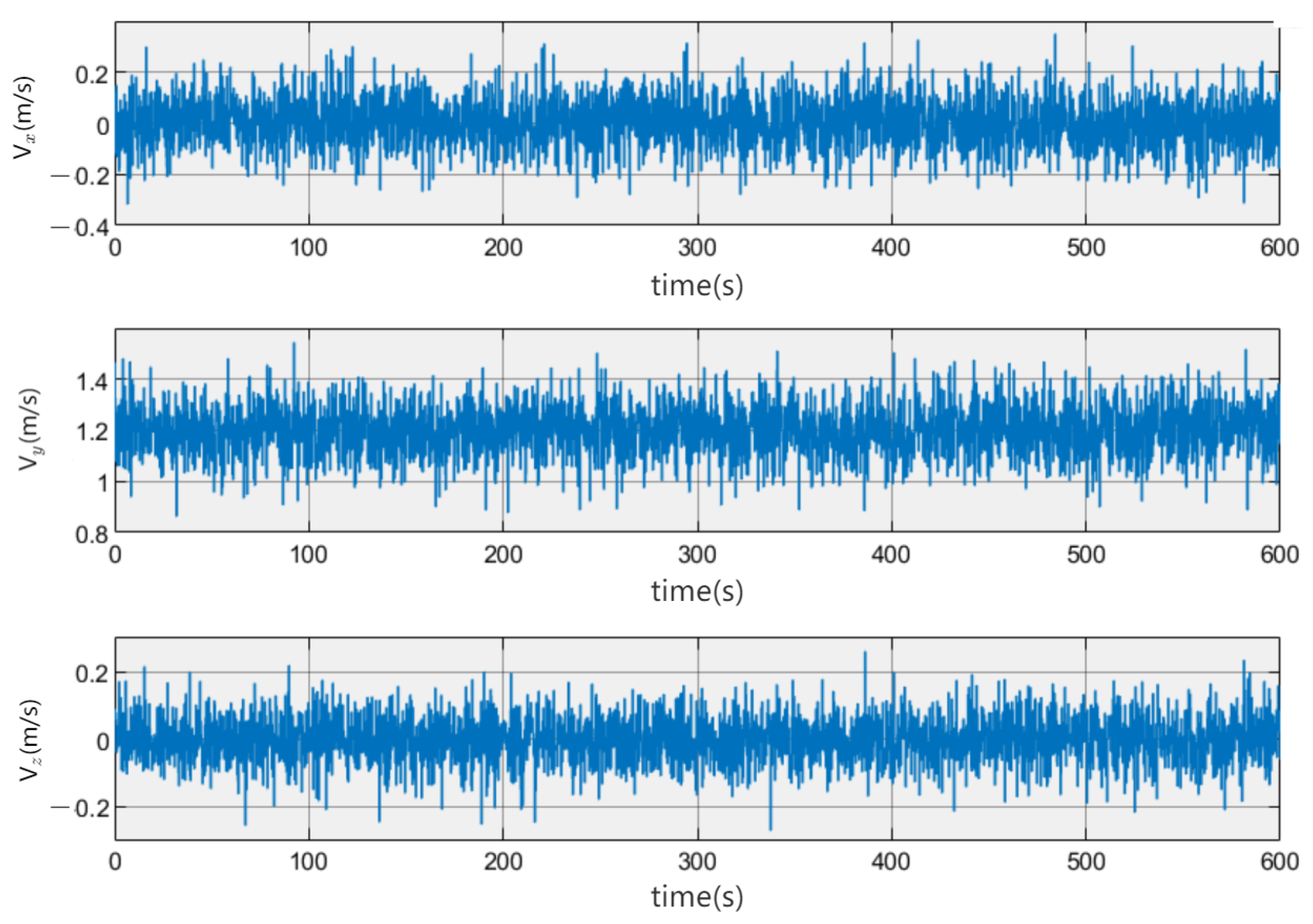



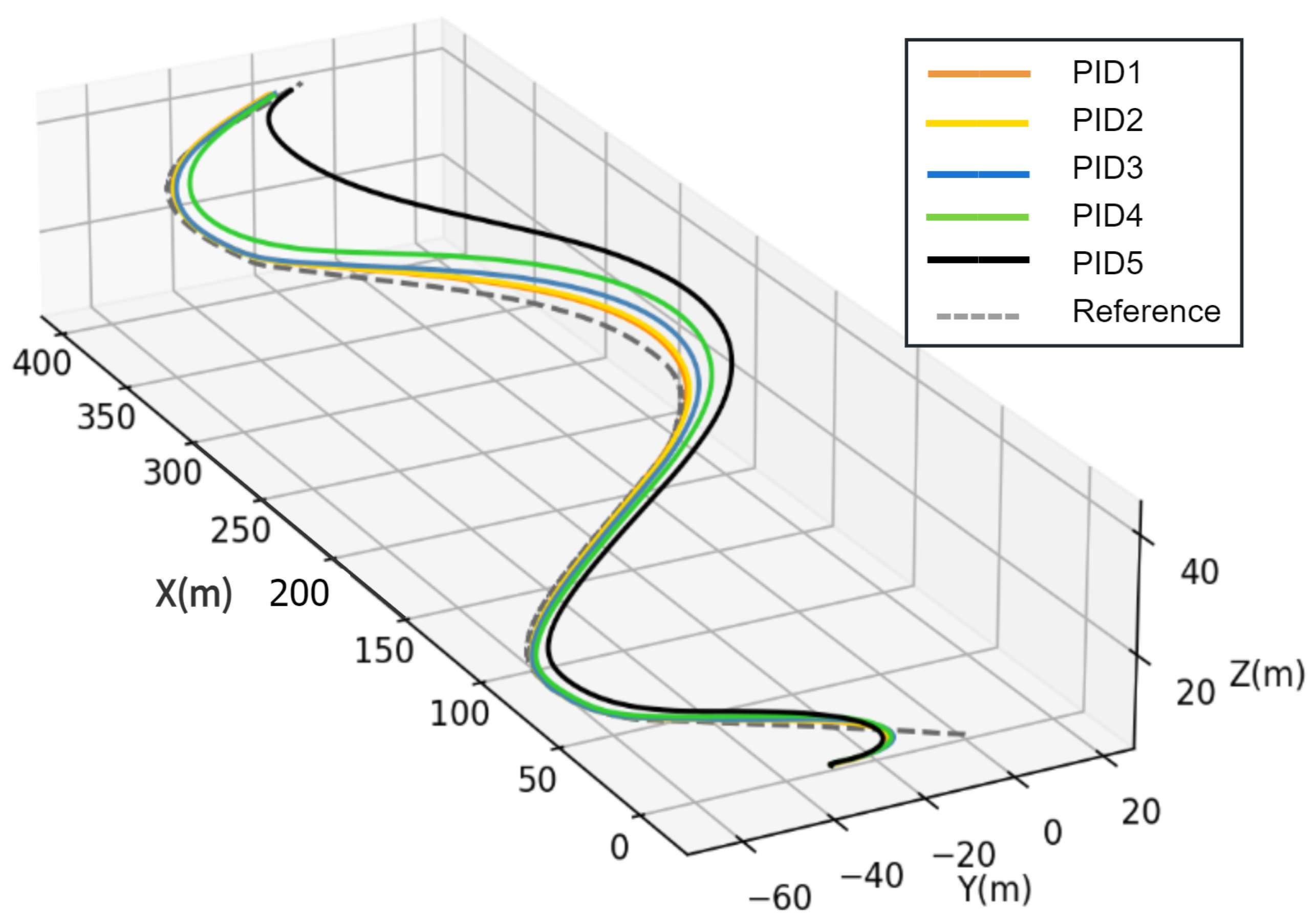
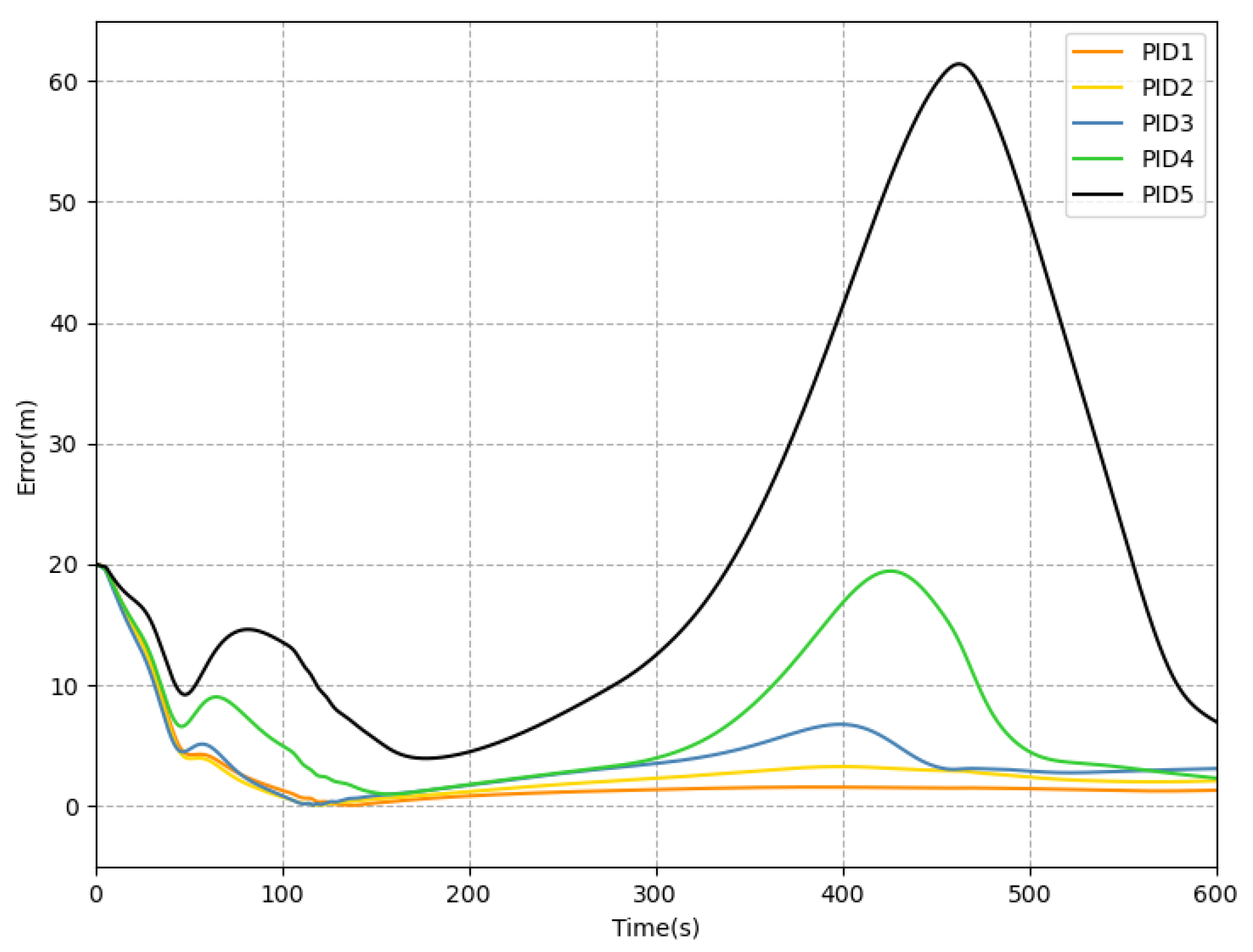

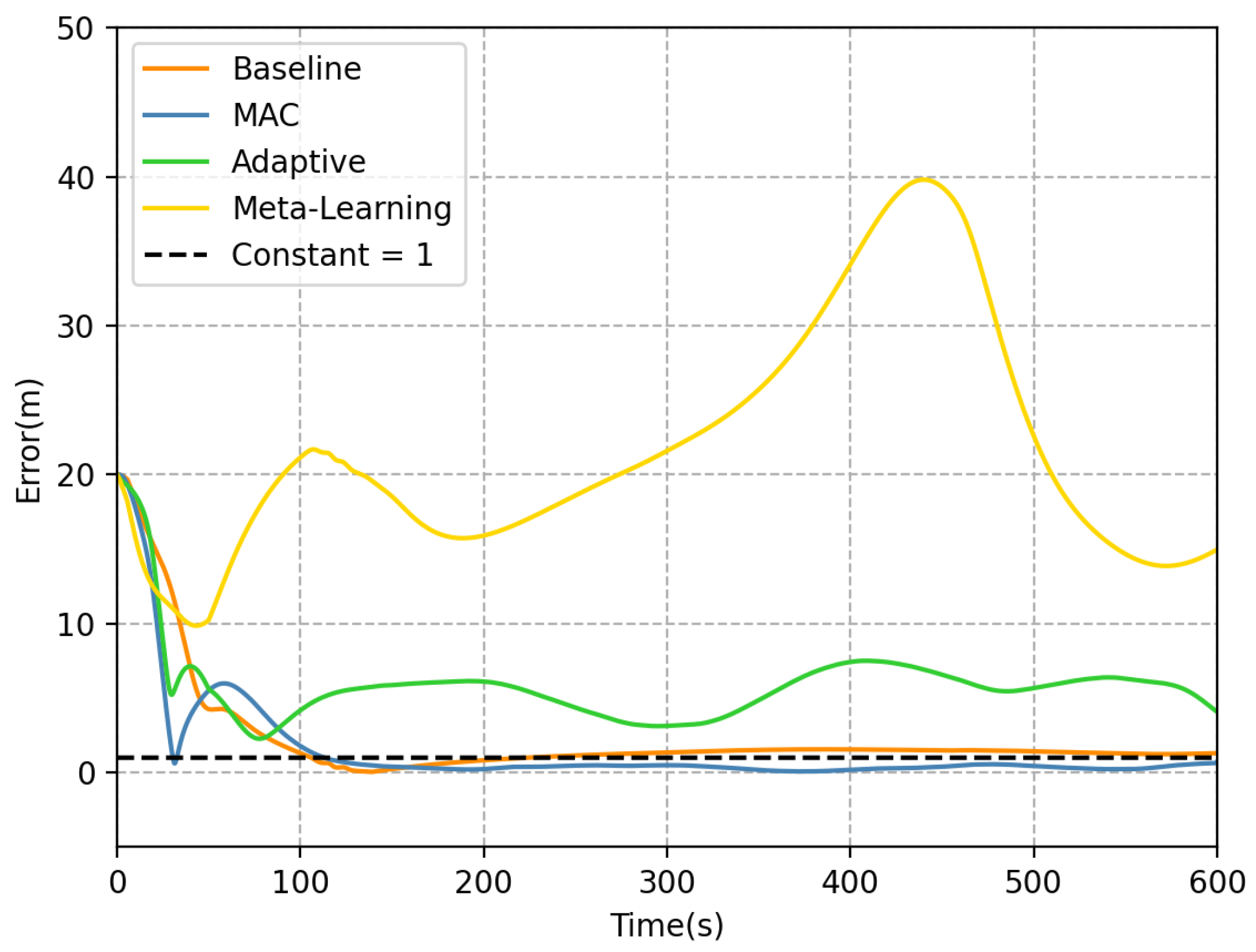
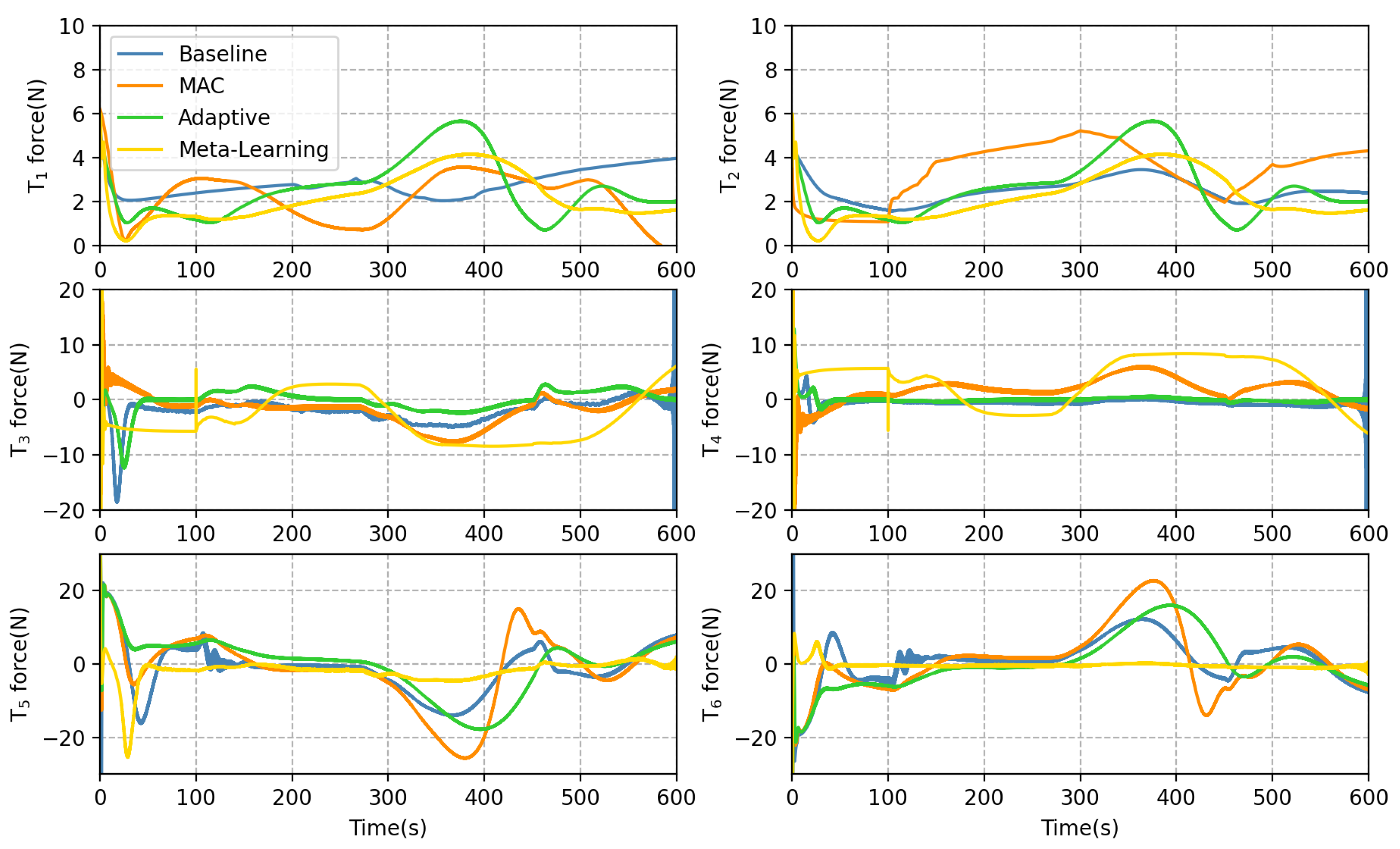
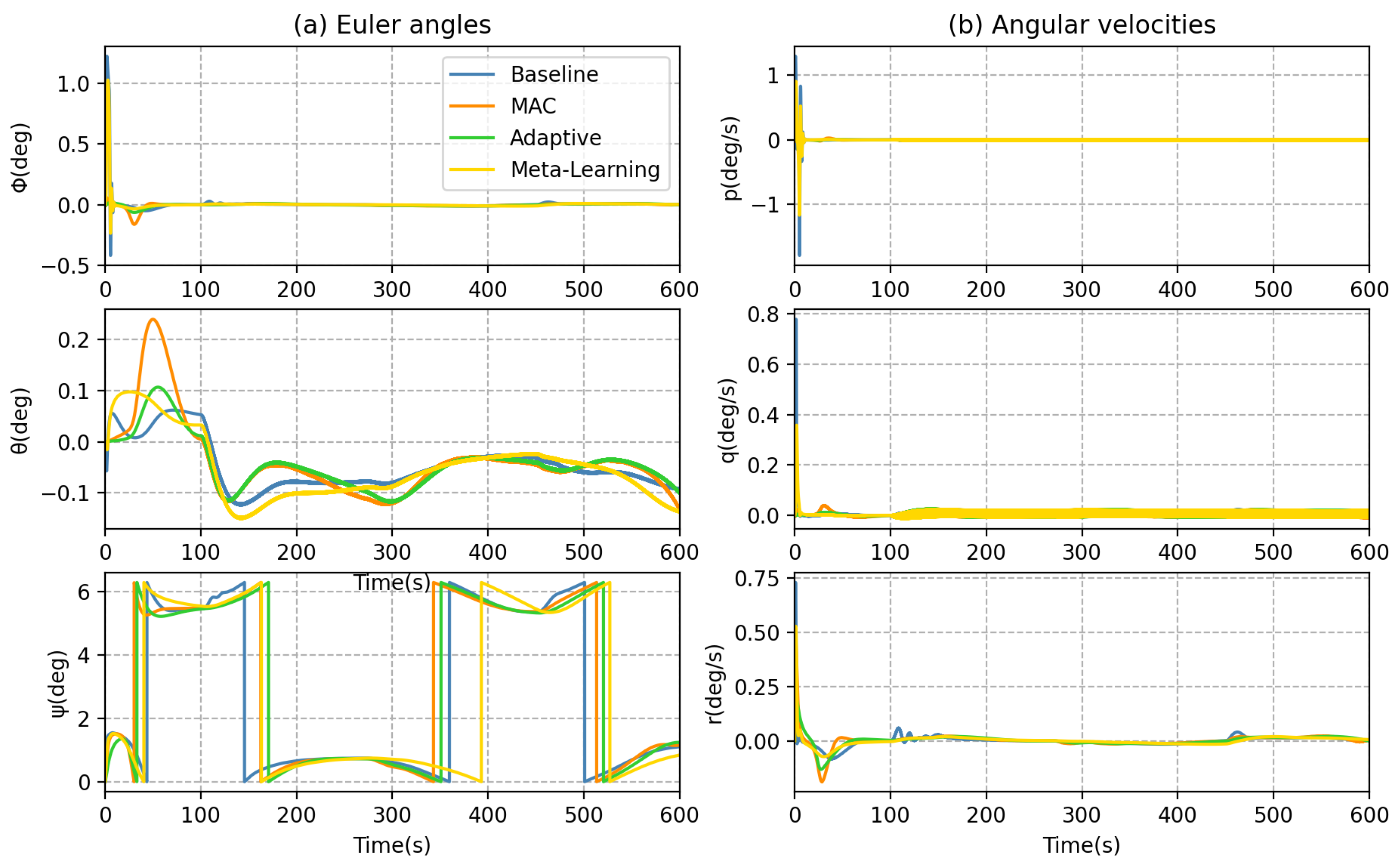


| Hyperparameter | Value |
|---|---|
| Architecture of net | |
| Architecture of h net | |
| k | 64 |
| 256 | |
| 0.1 | |
| l | 0.001 |
| 0.0005 | |
| 15 | |
| q | 0.5 |
| 2 | |
| 500 |
| Methos | RMSE | Unit | |||
|---|---|---|---|---|---|
| PID1 | 1.157 | 1.629 | 0.016 | 1.998 | m |
| PID2 | 1.679 | 1.961 | 0.017 | 2.582 | m |
| PID3 | 1.893 | 2.984 | 0.021 | 3.533 | m |
| PID4 | 2.381 | 6.161 | 0.184 | 6.605 | m |
| PID5 | 12.175 | 15.844 | 0.045 | 19.982 | m |
| Average | 3.857 | 5.716 | 0.057 | 6.94 | m |
| Methos | RMSE | Unit | |||
|---|---|---|---|---|---|
| Baseline | 1.157 | 1.629 | 0.016 | 1.998 | m |
| MAC | 0.596 | 1.235 | 0.058 | 1.373 | m |
| Adaptive | 3.599 | 3.452 | 0.048 | 4.987 | m |
| Meta-Learning | 15.732 | 11.209 | 0.062 | 19.317 | m |
Disclaimer/Publisher’s Note: The statements, opinions and data contained in all publications are solely those of the individual author(s) and contributor(s) and not of MDPI and/or the editor(s). MDPI and/or the editor(s) disclaim responsibility for any injury to people or property resulting from any ideas, methods, instructions or products referred to in the content. |
© 2023 by the authors. Licensee MDPI, Basel, Switzerland. This article is an open access article distributed under the terms and conditions of the Creative Commons Attribution (CC BY) license (https://creativecommons.org/licenses/by/4.0/).
Share and Cite
Zhang, Y.; Che, J.; Hu, Y.; Cui, J.; Cui, J. Real-Time Ocean Current Compensation for AUV Trajectory Tracking Control Using a Meta-Learning and Self-Adaptation Hybrid Approach. Sensors 2023, 23, 6417. https://doi.org/10.3390/s23146417
Zhang Y, Che J, Hu Y, Cui J, Cui J. Real-Time Ocean Current Compensation for AUV Trajectory Tracking Control Using a Meta-Learning and Self-Adaptation Hybrid Approach. Sensors. 2023; 23(14):6417. https://doi.org/10.3390/s23146417
Chicago/Turabian StyleZhang, Yiqiang, Jiaxing Che, Yijun Hu, Jiankuo Cui, and Junhong Cui. 2023. "Real-Time Ocean Current Compensation for AUV Trajectory Tracking Control Using a Meta-Learning and Self-Adaptation Hybrid Approach" Sensors 23, no. 14: 6417. https://doi.org/10.3390/s23146417
APA StyleZhang, Y., Che, J., Hu, Y., Cui, J., & Cui, J. (2023). Real-Time Ocean Current Compensation for AUV Trajectory Tracking Control Using a Meta-Learning and Self-Adaptation Hybrid Approach. Sensors, 23(14), 6417. https://doi.org/10.3390/s23146417




